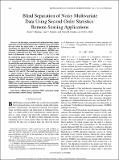| dc.contributor.author | Mueller, Amy V. | |
| dc.contributor.author | Herring, Keith T. | |
| dc.contributor.author | Staelin, David H. | |
| dc.date.accessioned | 2010-03-09T19:04:04Z | |
| dc.date.available | 2010-03-09T19:04:04Z | |
| dc.date.issued | 2009-09 | |
| dc.date.submitted | 2009-03 | |
| dc.identifier.issn | 0196-2892 | |
| dc.identifier.uri | http://hdl.handle.net/1721.1/52428 | |
| dc.description.abstract | In this paper a second-order method for blind source separation of noisy instantaneous linear mixtures is presented for the case where the signal order k is unknown. Its performance advantages are illustrated by simulations and by application to Airborne Visible/Infrared Imaging Spectrometer (AVIRIS) multichannel visible/infrared data. The model assumes that m mixtures x of dimension n are observed, where x = Ap + Gw, and the underlying signal vector p has k < n/3 independent unit-variance elements. A is the mixing matrix, G is diagonal, and w is a normalized white-noise vector. The algorithm estimates the Second-Order separation matrix A, signal Order k, and Noise and is therefore designated as SOON. SOON first iteratively estimates k and G using a scree metric, singular-value decomposition, and the expectation-maximization algorithm, and then determines the values of AP and W. The final step estimates A and the set of m signal vectors p using a variant of the joint-diagonalization method used in the Second-Order Blind Identification (SOBI) and Second-Order NonStationary (SONS) source-separation algorithms. The SOON extension of SOBI and SONS significantly improves their separation of simulated sources hidden in noise. SOON also reveals interesting thermal dynamics within AVIRIS multichannel visible/infrared imaging data not found by noise-adjusted principal-component analysis. | en |
| dc.description.sponsorship | United States Department of the Air Force (Contract F19628-00-C-0002) | en |
| dc.description.sponsorship | Lincoln Laboratory (Contract BX-8463) | en |
| dc.language.iso | en_US | |
| dc.publisher | Institute of Electrical and Electronics Engineers | en |
| dc.relation.isversionof | http://dx.doi.org/10.1109/tgrs.2009.2022325 | en |
| dc.rights | Article is made available in accordance with the publisher's policy and may be subject to US copyright law. Please refer to the publisher's site for terms of use. | en |
| dc.source | IEEE | en |
| dc.subject | separation | en |
| dc.subject | remote sensing | en |
| dc.subject | image representation | en |
| dc.subject | estimation | en |
| dc.subject | Blind signal separation (BSS) | en |
| dc.title | Blind Separation of Noisy Multivariate Data Using Second-Order Statistics: Remote-Sensing Applications | en |
| dc.type | Article | en |
| dc.identifier.citation | Herring, K.T., A.V. Mueller, and D.H. Staelin. “Blind Separation of Noisy Multivariate Data Using Second-Order Statistics: Remote-Sensing Applications.” Geoscience and Remote Sensing, IEEE Transactions on 47.10 (2009): 3406-3415. © 2009 IEEE | en |
| dc.contributor.department | Massachusetts Institute of Technology. Department of Civil and Environmental Engineering | en_US |
| dc.contributor.department | Massachusetts Institute of Technology. Department of Electrical Engineering and Computer Science | en_US |
| dc.contributor.department | Massachusetts Institute of Technology. Research Laboratory of Electronics | en_US |
| dc.contributor.approver | Staelin, David H. | |
| dc.contributor.mitauthor | Mueller, Amy V. | |
| dc.contributor.mitauthor | Herring, Keith T. | |
| dc.contributor.mitauthor | Staelin, David H. | |
| dc.relation.journal | IEEE Transactions on Geoscience & Remote Sensing | en |
| dc.eprint.version | Final published version | en |
| dc.type.uri | http://purl.org/eprint/type/JournalArticle | en |
| eprint.status | http://purl.org/eprint/status/PeerReviewed | en |
| dspace.orderedauthors | Herring, Keith T.; Mueller, A.V.; Staelin, D.H. | en |
| dc.identifier.orcid | https://orcid.org/0000-0001-8745-9006 | |
| mit.license | PUBLISHER_POLICY | en |
| mit.metadata.status | Complete | |
